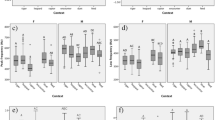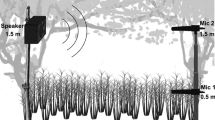Summary
-
1.
The pygmy marmoset, Cebuella pygmaea, has four trill variants in its vocal repertoire. One of these trills has a different behavioral message from the other three. However, the remaining trills, which were physically different from each other, did not seem to differ in their behavioral messages.
-
2.
The three trills can be ordered according to their acoustic cues for sound localization. This suggested that the most localizable trill is used when caller and recipient are far apart, while the least localizable trill is used only when animals are close together.
-
3.
A field study in the Peruvian Amozon showed that this was correct. Thus, pygmy marmosets seem to use selectively the variations in trill structure to minimize locatability when other cues are available for determining location and to maximize locatability when other means of determining location are absent.
-
4.
Pygmy marmoset trills contain mostly high frequency components which decay rapidly over short distances in humid, forested environments. However, these high frequencies are shown to be above the major frequencies of ambient noise in the environment, thus giving the pygmy marmoset a frequency window for communication. Furthermore, the frequencies of the marmoset trills are above the maximum auditory sensitivity of their major predators.
Similar content being viewed by others
References
Brown CH (in press) Auditory localization and primate vocal behavior. In: Snowdon CT, Brown CH, Petersen MR (eds) Primate communication. Cambridge University Press, New York
Brown CH, Beecher MD, Moody DB, Stebbins WC (1979) Locatability of vocal signals in Old World monkeys: Design features for the communication of position. J Comp Physiol Psychol 93:806–819
Cleveland J, Snowdon CT (in press) The complex vocal repertoire of adult cotton-top tamarins, Saguinus oedipus oedipus. Z Tierpsychol
Dooling RJ (1980) Behavior and psychophysics of hearing in birds. In: Popper AN, Fay RR (eds) Comparative studies of hearing in vertebrates. Springer, Berlin Heidelberg New York, pp 261–288
Hafter ER (1977) Lateralization model and the role of time intensity tradings in binaural masking: Can the data be explained by a time-only hypothesis? J Acoust Soc Am 62:633–635
Marler P (1959) Developments in the study of animal communication In: Bell PR (ed) Darwin's biological work. Cambridge University Press, Cambridge, pp 150–206
Marten K, Marler P (1977) Sound transmission and its significance for animal vocalizations: I. Temperate habitats. Behav Ecol Sociobiol 2:271–290
Marten K, Quine D, Marler P (1977) Sound transmission and its significance for animal vocalizations: II. Tropical forest habitats. Behav Ecol Sociobiol 2:291–302
Menzel CR (1980) Headcocking and visual perception in primates. Anim Behav 28:151–159
Morton ES (1975) Ecological sources of selection on avian sounds. Am Nat 108:17–34
Moynihan M (1967) Comparative aspects of communication in New World primates. In: Morris D (ed) Primate ethology. Weiderfeld and Nicolson, London, pp 236–266
Pola YV, Snowdon CT (1975) The vocalizations of pygmy marmosets (Cebuella pygmaea). Anim Behav 26:192–206
Ramirez MF, Freese CH, Revilla J (1978) Feeding ecology of the pygmy marmoset, Cebuella pygmaea, in Northeastern Peru. In: Kleiman DG (ed) The biology and conservation of the callitrichidae. Smithsonian Institution Press, Washington, DC, pp 91–104
Simmons JA (1973) The resolution of target range by echolocating bats. J Acoust Soc Am 54:157–173
Smith WJ (1977) The behavior of communicating. Harvard University Press, Cambridge, MA
Snowdon CT (in press) Linguistic and psycholinguistic approaches to primate communication. In Snowdon CT, Brown CH, Petersen MR (eds) Primate communication. Cambridge University Press, New York
Snowdon CT, Cleveland J (1980) Individual recognition of contact calls by pygmy marmosets. Anim Behav 28:717–727
Snowdon CT, Pola YV (1978) Interspecific and intraspecific responses to synthesized marmoset vocalizations. Anim Behav 26:192–206
Soini P (in press) Cebuella pygmaea. In: Mittermeier RA, Coimbra-Filho R (eds) Ecology and behavior of neotropical primates, vol 2. Brasilian Academy of Sciences, Brasilia
Thurlow WR (1971) Audition In: Kling JW, Riggs LA (eds) Experimental psychology. Holt, Rinehart and Winston, New York, pp 223–259
Vencl F (1977) A case of convergence in vocal signals between marmosets and birds. Am Nat 111:777–782
Waser PM (1977) Sound localization by monkeys: A field experiment. Behav Ecol Sociobiol 2:427–431
Waser PM, Waser MS (1977) Experimental studies of primate vocalization: Specializations for long-distance propagation. Z Tierpsychol 43:239–263
Wiley RH, Richards DG (1978) Physical constraints on acoustic communication in the atmosphere: Implications for the evolution of animal vocalizations. Behav Ecol Sociobiol 3:69–94
Author information
Authors and Affiliations
Rights and permissions
About this article
Cite this article
Snowdon, C.T., Hodun, A. Acoustic adaptation in pygmy marmoset contact calls: Locational cues vary with distances between conspecifics. Behav Ecol Sociobiol 9, 295–300 (1981). https://doi.org/10.1007/BF00299886
Received:
Accepted:
Issue Date:
DOI: https://doi.org/10.1007/BF00299886




